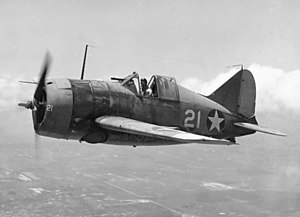Brewster F2A
| F2A Buffalo | |
|---|---|
 |
|
| Brewster F2A-3 in flight. | |
| Role | Fighter aircraft |
| National origin | United States |
| Manufacturer | Brewster Aeronautical Corporation |
| First flight | 2 December 1937 |
| Introduction | April 1939 |
| Retired | 1948 (Finland) |
| Status | Retired |
| Primary users |
United States Navy Finnish Air Force Royal Air Force Royal Australian Air Force |
| Produced | 1938–1941 |
| Number built | 509 |
| Developed into | VL Humu |
The Brewster F2A Buffalo was an American fighter aircraft which saw service early in World War II. Designed and built by the Brewster Aeronautical Corporation, it was one of the first U.S. monoplanes with an arrestor hook and other modifications for aircraft carriers. The Buffalo won a competition against the Grumman F4F Wildcat in 1939 to become the U.S. Navy's first monoplane fighter aircraft. Although superior to the Grumman F3F biplane it replaced and the early F4Fs, the Buffalo was largely obsolete when the United States entered the war, being unstable and overweight, especially when compared to the Japanese Mitsubishi A6M Zero.
Several nations, including Finland, Belgium, Britain and the Netherlands, ordered the Buffalo. The Finns were the most successful with their Buffalos, flying them in combat against early Soviet fighters with excellent results. During the Continuation War of 1941–1944, the B-239s (a de-navalized F2A-1) operated by the Finnish Air Force proved capable of engaging and destroying most types of Soviet fighter aircraft operating against Finland at that time and achieving in the first phase of that conflict 32 Soviet aircraft shot down for every B-239 lost, and producing 36 Buffalo "aces".
In December 1941, Buffalos operated by both British Commonwealth (B-339E) and Dutch (B-339D) air forces in South East Asia suffered severe losses in combat against the Japanese Navy's Mitsubishi A6M Zero and the Japanese Army's Nakajima Ki-43 "Oscar". The British attempted to lighten their Buffalos by removing ammunition and fuel and installing lighter guns to improve performance, but it made little difference. After the first few engagements, the Dutch halved the fuel and ammunition load in the wing, which allowed their Buffalos (and their Hurricanes) to stay with the Oscars in turns.
...
Wikipedia
